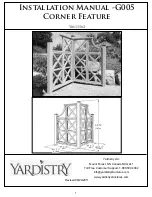
15
1.800.627.4499
PA-Series
ERV
1.4 SYSTEM DESIGN—BLOWER SIZING
1.4.1 Blower Sizing
See Figure 1.4.0 below for pressure drop through the PA ERVs. The chart does not include
allowances for inlet/outlet plenums, which are not included with the unit. The chart includes
pressure drop through clean filters.
In general, ventilation systems with energy-recovery components use blowers operating at
relatively high static pressure. Thus, parts of the duct system will be at higher-than-ordinary
static pressures, and greater duct leakage may result.
It is good practice to select blowers and motors that can be operated at higher total static
pressures than required by the nominal design. This provides a solution in the event that total
system pressure drop is higher than expected. Note that this means proper system balancing
and commissioning becomes even more important, in order to prevent operation at higher-than-
requried airflows.
FIGURE 1.4.0 PRESSURE DROP THROUGH PA-SERIES UNITS
1.4.2 Blower Inlet and Outlet Conditions
As in all applications of blowers in air-handling systems, imporper duct design at the inlet and
outlet of the blower can greatly reduce blower performace compared to its published ratings.
Complete guidelines on blower applications are beyond the scope of this document. The most
basic guidlines are:
AT THE BLOWER OUTLET:
u
Design a gradual transition to the final duct size.
u
Included angle between the transition elements should not exceed 7˚.
u
Transition length shoul be at least 2.5 times the equivalent duct diameters of the blower
outlet.
AT THE BLOWER INLET:
u
Design for no bends in the duct for at least 5 equivalent duct diameters of the blower inlet.
u
If a transition is needed at the duct connection to the blower, included angle between the
transition elements should not exceed 15˚.
Maximum Differential Pres-
sure
The maximum pressure
differential between the
two airstreams shound not
exceed 4 inches (H
2
O).
CAUTION
SYSTEM DESIGN
















































